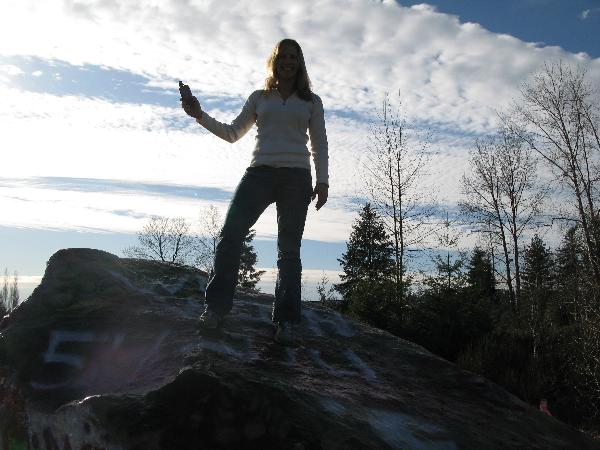The Best Little Rock in Snohomish EarthCache
The Best Little Rock in Snohomish
-
Difficulty:
-

-
Terrain:
-

Size:  (other)
(other)
Please note Use of geocaching.com services is subject to the terms and conditions
in our disclaimer.
A glacial erratic, as defined by Wikipedia, is a piece of rock that deviates from the size and type of rock native to the area in which it rests. The name "erratic" is based on the errant location of these boulders. These rocks were carried to their current locations by glacial ice, often over hundreds of miles. Erratics can range in size from pebbles to large boulders.
A flood borne erratic, also defined by Wikipeida, is when glacial ice is "rafted" by a flood such as that created when the ice dam broke during the Missoula floods. Erratics, encased in floating ice, were deposited where the ice finally melted and released its debris load.
Geologists identify erratics by studying the rocks surrounding the position of the erratic and the composition of the erratic itself. Erratics were once considered evidence of a massive flood approximately 10,000 years ago, similar to the legendary floods described in the texts of ancient civilizations throughout the world.
Ancient legends of epic floods come from many cultures, but in the 19th century, many scientists came to favor erratics as evidence for the end of the ice age 10,000 years ago, rather than a flood. Geologists have suggested that landslides or rock falls initially dropped the rocks on top of glacial ice. The glaciers continued to move, carrying the rocks with them. When the ice melted, erratics were left in their present locations.
Now that we've defined erratics, both glacial and flood-borne, let's talk about rocks.
In geology, rocks are naturally occurring aggregates of minerals and/or mineraloids. The Earth's lithosphere is made of rock. In general there are three types of rocks - igneous, sedimentary, and metamorphic.
Igneous rocks are formed when molten magma cools and are divided into two main categories: plutonic rock and volcanic. Plutonic or intrusive rocks result when magma cools and crystallizes slowly within the Earth's crust (example granite), while volcanic or extrusive rocks result from magma reaching the surface either as lava or fragmental ejecta. Common examples of igneous rocks include pumice and basalt.
Metamorphic Rocks are formed by subjecting any rock type (including previously formed metamorphic rock) to different temperature and pressure conditions than those in which the original rock was formed. These temperatures and pressures are always higher than those at the Earth's surface, and must be sufficiently high so as to change the original minerals into other mineral types or into other forms of the same minerals. Common examples of metamorphic rocks include slate, schist, gneiss, and marble.
Sedimentary Rocks are formed by deposition of either clastic sediments, organic matter, or chemical precipitates (evaporites), followed by compaction of the particulate matter and cementation during diagenesis. Sedimentary rocks form at or near the Earth's surface.
The three classes of rocks - igneous, sedimentary and metamorphic, are subdivided into many groups. There are, however, no hard and fast boundaries between allied rocks.

I like to provide historical details for our Earthcaches, but after talking to City Hall, the Visitor Center and the Historical Society I learned only two things: this rock has been here for a long time, and the kids have always painted it. So you might say this erratic has a rather colorful history, even though no one seems to know anything about it. Say what you will about kids defacing it with paint, but I think it's kind of interesting to see the continually evolving piece of art.
It is commonly accepted that erratics were dropped from glaciers as they retreated. That's probably true for larger boulder-sized erratics, but what about the 'pebble-sized' erratics, like this one?? Is it possible that this erratic was deposited via flood and not the commonly accepted dropped-from-a-glacier theory??
To log this earthcache, please email me answers to the questions below on the same day that you log your successful find of this earthcache. Do not include the answers in your online log. Online logs without the answers emailed to me on the same day risk deletion. If you are concerned that there could be an issue, save your answers in the "Personal Cache Note" section near the top of the cache page. (That might be good general practice, anyway.)
1. Identify the elevation at GZ.
2. With your GPS' pointer on the map screen, locate the Snohomish River, how far is it from the erratic?
3. Using the definitions above, compare the erratic with at least two other rocks in the vicinity. Are they the same or different?? Why? Using your geo-Jedi earthcaching observation skills, take into account any noticeable gouge marks, the elevation at GZ, the distance from the river and the classification of the erratic and then decide if this erratic was deposited via glacier or flood. Support your theory.
4. Although not required, a photo of you and/or your party would be appreciated.
Lastly, there is often litter here. :( A little bit of CITO on your part may help.
Additional Hints
(No hints available.)